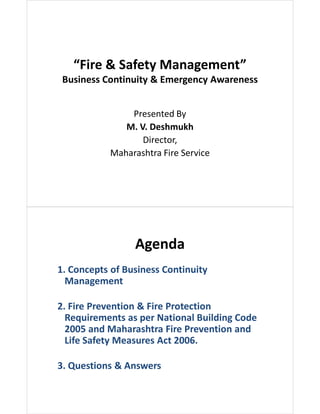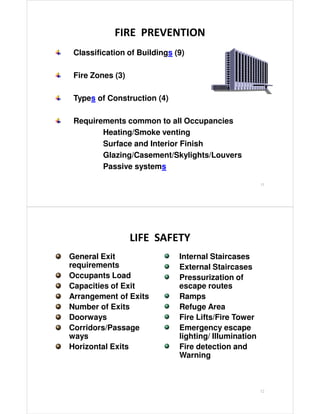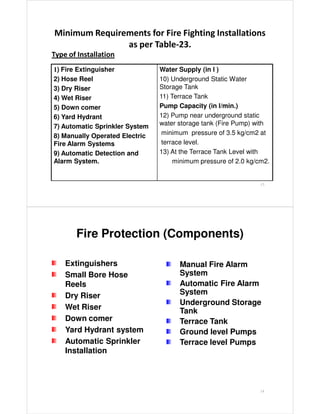fire_safety_management.pdf
- 1. âFire & Safety Managementâ Business Continuity & Emergency Awareness Presented By M. V. Deshmukh Director, Maharashtra Fire Service Agenda 1. Concepts of Business Continuity Management 2. Fire Prevention & Fire Protection Requirements as per National Building Code 2005 and Maharashtra Fire Prevention and Life Safety Measures Act 2006. 3. Questions & Answers
- 2. Business Continuity Management âĒ Uncertainty is a way of life! âĒ Organizations need to proactively respond to disasters âĒ Business Continuity and Emergency Awareness helps to be prepared âĒ Better preparation leads to effective response to emergency situations âĒ Your companyâs survivability and the survivability of other companies in your supply chain depend on you âĒ Economic dependence of the community-at-largeâĶ What is Business Continuity Management? Business Continuity Management (BCM) âĒ Identifies potential impacts âĒ Provides a framework for Continuity Management âĒ Helps defining the Disaster Recover Plan (DRP) Prepare BCP Risk Mitigation Strategies Proactive actions Post disaster activities Disaster Initial response Recovery Activities Resumption Activities After operations stabilise at recovery location Ongoing Plan Maintenance BCP Maintenance Updated BCP
- 3. Safe Built Environment 5 Structural Safety Health Safety Fire Safety Construction Safety Electric Safety Environment Safety Life Safety Public Safety Built around the philosophy of creating and maintaining Safe Built Environment for people and property by ensuring: Classification of Buildings as per NBC 2005 Group A Residential Group B Educational Group C Institutional Group D Assembly Group E Business Group F Mercantile Group G Industrial Group H Storage Group J Hazardous 6
- 4. SAFETY CONCERNS One of the distinct developments brought out in NBC-2005 is an emphasis on safety concerns in buildings NBC-2005 considered safety as an important requirement in buildings starting from construction stage till it exists. Ensures safe built environment for all types of occupancies. 7 PART 4 : FIRE AND LIFE SAFETY Deals with Safety from Fire. Exits in Building V/S Importance of Life Safety. Involvement of Qualified Trained Fire Protection Engineers from the very beginning. Standards Laid Down to provide safety from fire. Potential Panic Hazard â measures to minimize Panic hence control on accidents. Flexibility V/S Rigidity. Limitation of Height and areas of Building for Occupants Safety. Phasing out of Ozone Depleting Substance- Under Country Program. New standards have been already developed and put in place for Halon alternative clean agents. 8
- 5. NBC 2005 - Philosophical Change Test Divided into various Clauses resulting in increased Understanding, Technological Correction better Application :- Fire Prevention. Life Safety. Fire Protection. Besides, Provisions specific to High rise buildings and also useful information on Industrial Venting have been retained with some useful updates. 9 ABSOLUTE SAFETY FROM FIRE IS NOT ATTAINABLE IN PRACTICE The objective of this part is to specify measures that will provide that degree of safety from fire which can be reasonably achieved. The Code endeavors to avoid requirements that might involve unreasonable hardships or unnecessary inconvenience or interference with normal use and occupancy of buildings, insist upon compliance with minimum standards for fire safety necessary in public interest. It is desirable to use such equipments/installation duly certified under the BIS Certifications Marks Scheme. 10
- 6. FIRE PREVENTION Classification of Buildings (9) Fire Zones (3) Types of Construction (4) Requirements common to all Occupancies Heating/Smoke venting Surface and Interior Finish Glazing/Casement/Skylights/Louvers Passive systems 11 LIFE SAFETY General Exit requirements Occupants Load Capacities of Exit Arrangement of Exits Number of Exits Doorways Corridors/Passage ways Horizontal Exits Internal Staircases External Staircases Pressurization of escape routes Ramps Refuge Area Fire Lifts/Fire Tower Emergency escape lighting/ Illumination Fire detection and Warning 12
- 7. Minimum Requirements for Fire Fighting Installations as per Table-23. Type of Installation 13 1) Fire Extinguisher 2) Hose Reel 3) Dry Riser 4) Wet Riser 5) Down comer 6) Yard Hydrant 7) Automatic Sprinkler System 8) Manually Operated Electric Fire Alarm Systems 9) Automatic Detection and Alarm System. Water Supply (in l ) 10) Underground Static Water Storage Tank 11) Terrace Tank Pump Capacity (in l/min.) 12) Pump near underground static water storage tank (Fire Pump) with minimum pressure of 3.5 kg/cm2 at terrace level. 13) At the Terrace Tank Level with minimum pressure of 2.0 kg/cm2. Fire Protection (Components) Extinguishers Small Bore Hose Reels Dry Riser Wet Riser Down comer Yard Hydrant system Automatic Sprinkler Installation Manual Fire Alarm System Automatic Fire Alarm System Underground Storage Tank Terrace Tank Ground level Pumps Terrace level Pumps 14
- 8. Passive Fire Protection Fighting Natural Calamities â Common Guiding Document. Refuge Area for High Rise Buildings Types of Construction and Openings Fire Stops/Enclosure of Openings Air-conditioning/Ventilation (dampers) Surface of Flame Spread definitions Glazing/Skylights (Wired Glass) 15 Passive Fire Protection âĒ Travel Distance based on Type of Construction. âĒ Occupant Load. âĒ Number of Exits in Building. âĒ Width of Staircases and Passage âĒ Compartmentation of floor area.
- 9. âĒ The existing building regulatory media are normally silent / deficient with respect to many of NBC provisions, in general and disaster resistant mitigation features, in particular âĒ Many countries have comprehensive national building code or national standards/ for disaster protection for earthquake resistant/ cyclone resistant design and construction practices which are recommendatory and do not have the mandatory status for local application. âĒ There are equally good examples of providing protection to People and Property through safe construction by insisting on mandatory building codes (Seattle, NBC of Canada, UK Building Regulations, Japanese Codes) 17 ENFORCEMENT 18 The Building Regulatory Media consist of Building Byelaws Building Rules Planning Standards Development Control Rules Fire Act / Regulations Town Planning Act / Rules Hazard Mapping Rules Water Supply Byelaws Drainage Byelaws These regulatory These regulatory documents have documents have to be brought in to be brought in line with line with NBC 2005 NBC 2005
- 10. Therefore, the National Building Code should be made part or integrated with the building regulatory documents like the building bye-laws, planning standards, building rules or development control rules and also made part of the building regulatory practices at various stages governing building development in cities, towns and villages 19 ENFORCEMENT Techno-Legal Regime âĒ This could either be incorporated in the local building regulatory documents or made as âdeemed to satisfyâ provisions by reference. Then automatic compliance is met with. Where needed, it can be adopted or adapted to cater to local variations, if any. This provides a Techno-legal Regime âĒ Maharashtra Government initiative is a pioneering step, as per provisions of Maharashtra Fire Prevention Life Safety Measures Act 2006, provisions of NBC 2005 are mandatory. Some of the State / City Governments have made NBC 2005 as part of the Building Rules / Fire Protection Rules for mandatory effect 20
- 11. ENFORCEMENT 21 Introducing Techno-legal regime through provisions in building regulatory media and its application during the stages of âĒ Building Permit âĒ Development Permit âĒ Supervision Control âĒ Completion Certificate âĒ Occupancy Permit âĒ Periodic Renewal Certificate ENFORCEMENT 22 To mandatorily associate the right level of professionals (architects, engineers, structural engineers, supervisors, town planners, urban designers, landscape architect, fire protection engineers professionals for utility services)of degree/diploma or certificate level depending on âĒ The nature of building (type, size, area, height) âĒ The location ( mega /metro city, medium/small town and villages)
- 12. 90% content of all City Building Byelaws are based on contents of Part II and Part III of NBC; 5% based on Part IV and balance 5% on all other Parts Part II Administration of NBC contain A series of reforms in building permit process. Provisions for ensuring and certification of safety of buildings against natural disaster by engineer and structural engineer. Provision for two stage permit for high rise residential and special buildings. 23 Adoption of NBC 2005 WAY FORWARD Provision for periodic renewal certificate of occupied buildings from structural, fire, electrical and health safety point of view. Provision for empowering engineers and architects for sanctioning plans of residential buildings upto 500mÂē. Therefore Part II of NBC 2005 to be used in full / part for revamping existing Building Byelaws 24
- 13. Adoption of NBC 2005 WAY FORWARD Fire Safety norms are very rarely included in Building Rules. Some Fire Safety regulations (excepting Mumbai, Delhi, Kolkata) are provided recently Part-IV of NBC contain revamped Fire safety norms through detailed provisions on Fire Prevention, Life Safety and Fire Protection Therefore full adoption of Part IV of NBC 2005 should be done, without any variations. Some contents can be directly included in the Building Rules on exit requirements, fire protection options. 25 Towards Safe Built Environment .... 26 Thank you for your kind attention Questions Answers












